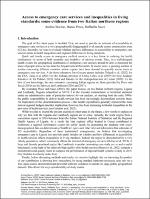Chapter Access to emergency care services and inequalities in living standards: Some evidence from two Italian northern regions
| dc.contributor.author | Succi, Raffaella | |
| dc.contributor.author | MARINO, ANDREA | |
| dc.contributor.author | Pesce, Marco | |
| dc.date.accessioned | 2023-08-03T15:05:59Z | |
| dc.date.available | 2023-08-03T15:05:59Z | |
| dc.date.issued | 2023 | |
| dc.identifier | ONIX_20230803_9791221501063_92 | |
| dc.identifier.issn | 2704-5846 | |
| dc.identifier.uri | https://library.oapen.org/handle/20.500.12657/74896 | |
| dc.description.abstract | Rapid access to emergency medical care is crucial in reducing the implications of negative health events in terms of both mortality and disability. Thus, in a well-designed health system the geographical distribution of emergency care services should be able to minimize the share of people whose access time lies beyond critical thresholds. In spite of this, statistical information measuring accessibility to emergency care services at a highly disaggregated level is unavailable in Italy. This paper makes a step in filling this gap, by providing geographically detailed estimates of accessibility in two northern regions, Liguria and Lombardia. To do so, we use three data sources: 1) georeferenced population data measured at the currently most possible detailed level (census enumeration areas, CEAs) from the 2011 Population Census; 2) open data on location of emergency care services; 3) crowdsourced data on road travel distances. Elaborating these data with an efficient algorithm based on open source routing machine provides us with a clear mapping of particularly disadvantaged areas. We find that in 2013 the population share whose access time to emergency care services lies beyond a critical –and policy relevant- threshold of 60 minutes is fairly limited (about 0.1% in both regions). Regional differences emerge when setting lower thresholds. We briefly discuss how accessibility may have evolved in recent years, based upon some conjecture on population dynamics at the CEA level and updated information on emergency care centers. Finally, we analyze how differences in accessibility are related to a set of characteristics describing the population’s living conditions. Different results emerge. In particular, older and less educated people in Liguria face significantly lower access to emergency care. Overall, our results suggest that spatial differences in accessibility -within and between regions- should be considered a relevant determinant of health inequality. | |
| dc.language | English | |
| dc.relation.ispartofseries | Proceedings e report | |
| dc.subject.classification | thema EDItEUR::J Society and Social Sciences | en_US |
| dc.subject.other | emergency care accessibility | |
| dc.subject.other | health inequalities | |
| dc.subject.other | efficient routing algorithms on open (big) data | |
| dc.title | Chapter Access to emergency care services and inequalities in living standards: Some evidence from two Italian northern regions | |
| dc.type | chapter | |
| oapen.identifier.doi | 10.36253/979-12-215-0106-3.24 | |
| oapen.relation.isPublishedBy | 9223d3ac-6fd2-44c9-bb99-5b98ca9d2fad | |
| oapen.relation.isPartOfBook | 863aa499-dbee-4191-9a14-3b5d5ef9e635 | |
| oapen.relation.isbn | 9791221501063 | |
| oapen.series.number | 134 | |
| oapen.pages | 6 | |
| oapen.place.publication | Florence |

